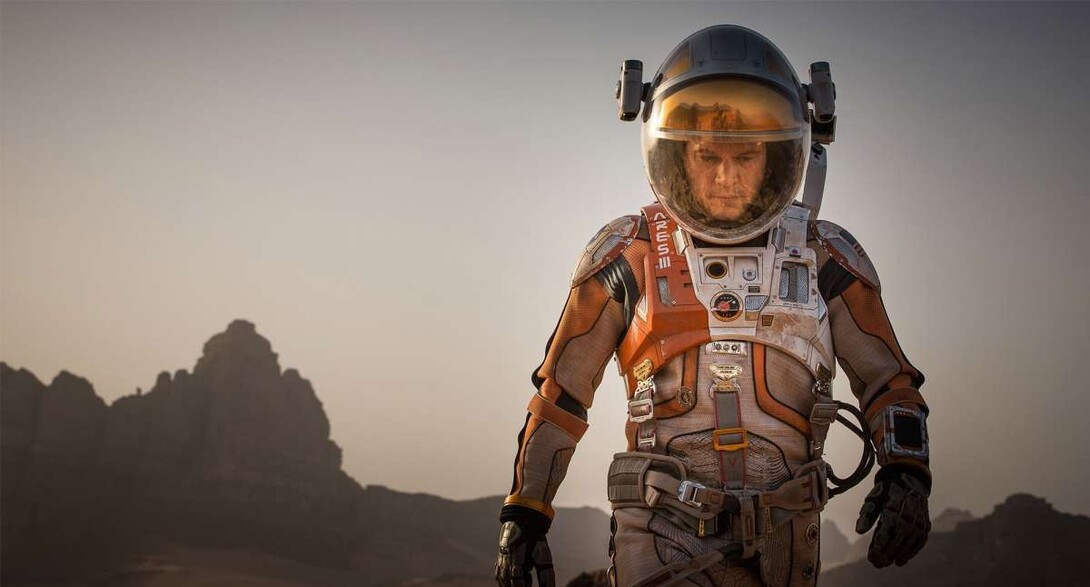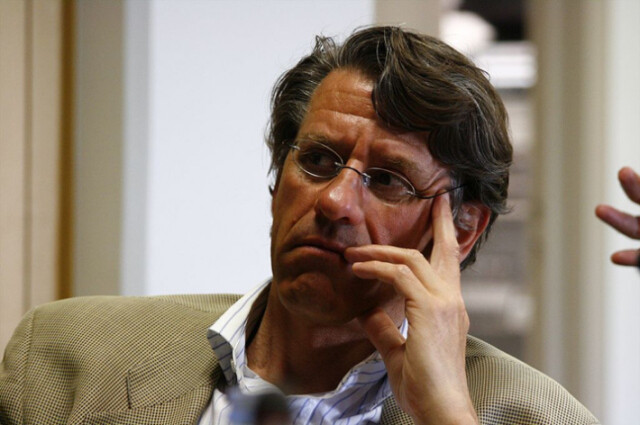
It’s been a white-hot stretch for the ice-cold Red Planet.
On Sept. 28, NASA revealed the most compelling evidence yet that liquid water flows at least intermittently on the surface of Mars. The much-publicized announcement coincides with this weekend’s theatrical release of “The Martian,” a film based on the 2011 novel by Andy Weir.
The film, which stars Matt Damon and Jessica Chastain, follows astronaut Mark Watney (Damon) as he endeavors to survive being stranded on Mars. On the eve of the movie’s opening, Husker researchers weighed in on a few of the science, legal and engineering scenarios presented in the story.
The following contains mild spoilers unrelated to the ending of the book and film.
Martian soil + Earth soil + Manure + Water = Potato garden?
Watney was selected for the manned mission to Mars partly because of his background in botany. Soon after realizing he’s alone on the planet, he begins brainstorming how he might grow food that would allow him to survive after his rations run out.
Watney has a few tools at his disposal: a small amount of soil from Earth, a few potatoes, some water and a sizable pod that simulates the atmospheric conditions of Earth. He mixes Martian soil with the water, Earth soil and his feces, hypothesizing that the latter two ingredients will turn the Martian soil fertile by encouraging the spread of essential bacteria.
As Watney says in the novel: There are dozens of species of bacteria living in Earth soil, and they’re critical to plant growth. They’ll spread out and breed like…well, like a bacterial infection…. Within a week, the Martian soil will be ready for plants to germinate in. But I won’t plant yet. I’ll bring in more lifeless soil from outside and spread some of the live soil over it. It’ll “infect” the new soil and I’ll have double what I started with. After another week, I’ll double it again. And so on. Of course, all the while, I’ll be adding all new manure to the effort.
By cutting his potatoes into quarters and planting them in the new soil, Watney successfully grows 400 potato plants in 10 centimeter-deep soil over the course of several months. But would this actually work?
“I do think this method is feasible, but there are many hurdles to overcome and many caveats that would need to be satisfied before this would be possible,” said Josh Herr, an assistant professor of plant pathology who works at Nebraska’s Center for Plant Science Innovation.
One of the primary hurdles, Herr said, would be collecting Martian soil that contains carbon – a building block of all known organisms. Though a recent NASA mission found traces of organic carbon in Martian rock samples, much remains unknown about its presence on the planet.
“Crop plants need microbes to mobilize nutrients and water from the soil and provide these to the root interface,” Herr said. “And microbes need the soil nutrients, water, and carbon from the plant to survive. There would need to be some carbon in the Martian soils to sustain the microbes’ growth prior to optimal carbon (being released) from the plant root.
“I don’t know if we have a good idea of the specific chemistry of the Martian soils, but the chemical conditions would have to be just right – in the ‘Goldilocks zone’ – to support microbial life and provide nutrients for plants.”
Herr said Watney’s notion of fertilizing the soil with his feces is more promising – though maybe not even necessary.

“This is not so far-fetched, as much of our gut content is the ‘same’ as the soil’s,” he said. “In fact, some of our gut contents have probably been established by food inputs that gained microbes from the soil in the first place, so I would think this circle of microbial life is possible for inoculating Martian soils.
“While using feces would be an option, many plants naturally have microbes on and inside their parts, such as the potato tubers, which would be suitable to start microbial growth in the Martian soils – no inoculation required.”
Yet even if the Martian soil proved a suitable new home for the microbes, the time frame presented in the novel remains a problem, according to Herr. Watney manages to “inoculate” new Martian soil every week, getting his potato farm up and running in mere months. Unfortunately, Herr said, this just isn’t realistic.
“One week is far too quickly for this to take place,” he said. “(You would need) years, at least – probably decades or even longer – for a large growth chamber to establish microbial colonization.”
Space pirate?
Mark Watney’s mission is the third manned expedition to Mars, where he resides in a NASA-built “Hab” and drives a NASA rover on the planet’s surface. In a desperate bid to survive, he eventually decides to try driving the rover to a NASA lander that was sent to Mars in preparation for another manned mission taking place roughly four years after his own.
In the meantime, he gets to thinking about Martian law: There’s an international treaty saying no country can lay claim to anything that’s not Earth. And by another treaty, if you’re not in any country’s territory, maritime law applies. So Mars is “international waters.” NASA is an American nonmilitary organization, and it owns the Hab. So while I’m in the Hab, American law applies. As soon as I step outside, I’m in international waters. Then when I get in the rover, I’m back to American law. Here’s the cool part: I will eventually go … commandeer the Ares 4 lander. Nobody explicitly gave me permission to do this, and they can’t until I’m aboard Ares 4 and operating the comm system. After I board Ares 4, before talking to NASA, I will take control of a craft in international waters without permission. That makes me a pirate! A space pirate!
Watney is referencing the Outer Space Treaty signed by the United States and the former Soviet Union in 1967, said Frans von der Dunk, an Othmer Professor of Space Law at Nebraska.

“Basically agreed upon by the two giant Cold War adversaries, the idea was to prevent the historic land grabs of colonialist times from extending to outer space – thereby hopefully preventing it from becoming another battleground,” said von der Dunk, a foremost authority on space law. “It is often hailed as the Magna Carta of outer space, meaning it serves as the grand framework treaty providing the overarching legal regime for all human activity … in outer space, based on freedom for all to peacefully explore and use (it).”
Von der Dunk generally agreed with Watney’s interpretation of the treaty, saying that “individual space objects … can be made to fall under the quasi-territorial jurisdiction of the state of registry, just like ships or aircraft registered (on Earth).”
As for Watney’s claim to space piracy?
“One could make that argument, yes,” von der Dunk said. “But I would be careful, for analogies with sea piracy are difficult here. If this qualifies as a real emergency, he might well be in his right to grab any craft that could help him out of dire straits if he is not directly endangering others.”
Red rover, red rover…
Watney spends a fair amount of his time in a rover that he eventually customizes for long-distance travel. During his drives, he uses various means to help navigate the planet.
Shane Farritor, a Lederer Professor of Engineering, has worked on rover designs at Nebraska and, earlier in his career, as a graduate student at the Massachusetts Institute of Technology. While at MIT, he contributed to a sun sensor design that eventually found its way onto the Spirit, Opportunity and Curiosity rovers. As both Farritor and Watney noted, Mars’ magnetic field is too weak to support the use of a compass. Fortunately, the sun remains a faithful guide – if you can do some math.
“So you look up in the sky and find the sun, because it’s the brightest object,” Farritor said. “If you know what latitude you’re at, along with the time of day and some other information, you can calculate whether you’re going north, south, east or west.”

Farritor also spent a year at NASA’s Jet Propulsion Laboratory, which built the Sojourner lander that carried the Pathfinder rover to Mars’ surface in 1997. Watney eventually tracks down Sojourner and Pathfinder in the hope of re-establishing communications with Earth. In doing so, Farritor said, Watney fictionally answers a real question that Pathfinder’s design team has wondered about for nearly two decades.
“The interesting thing about that, as they describe in the book, is that the failure of that mission was that the battery failed on the lander,” Farritor said. “The lander was the link back to Earth; the rover only spoke to the lander, and the lander talked to Earth. (But) when the lander died … there was a (protocol) on the rover that said, ‘I can’t hear from you. You haven’t talked to me in a while, but I’m going to keep exploring and keep sending information.’
“Everybody who worked on that mission is just desperate to find out how far that rover made it. It could’ve lasted another year, for all we know.”
At Nebraska, Farritor has researched how multiple robots, tethered together, might descend and explore the steep cliffs that Watney takes great pains to avoid in his rover. Exploring these cliffs, Farritor said, could give researchers a closer look at the geologic layers that tell the history of a planet. These types of slopes also feature streaks that offer the signs of flowing water reported by NASA earlier in the week.
“There are ravines that look like water flows on Mars,” Farritor said. “There are places in the bottom that are white in the winter and red in the summer, which implies that there might be some liquid water at those sites. Those are the sites you might want to visit first.”
And Farritor, who said the mission architecture described in “The Martian” could serve as a solid model for visiting Mars, believes it’s only a matter of time before someone sets foot on the Red Planet.
“I think we’ll definitely go there,” he said. “I don’t have any doubt that it will occur. I think the timeline – and who goes – is up for grabs.
“I would love to see the United States do something very similar to this. I think this is a very, very bold thing, but I’d like to see it happen some day.”







